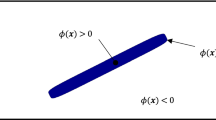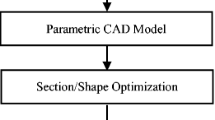Abstract
Most engineering artifacts are designed and analyzed today within a 3-D computer aided design (CAD) environment. However, slender objects such as beams are designed in a 3-D environment, but analyzed using a 1-D beam-element, since their 3-D analysis exhibits locking and/or is computationally inefficient. This process is tedious and error-prone. Here, we propose a dual-representation strategy for designing and analyzing 3-D beams, directly within a 3-D CAD environment. The proposed method exploits classic 1-D beam physics, but is implemented within a 3-D CAD environment by appealing to the divergence theorem. Consequently, the proposed method is numerically and computationally equivalent to classic 1-D beam analysis for uniform cross-section beams. But, more importantly, it closely matches the accuracy of a full-blown 3-D finite element analysis for non-uniform beams.















Similar content being viewed by others
References
Requicha AG (1980) Representations for rigid solids: theory, methods, and systems. ACM Comput Surv (CSUR) 12(4):437–464
Fu MW, Ong SK, Lu WF, Lee IBH, Nee AYC (2003) An approach to identify design and manufacturing features from a data exchanged part model. Comput Aided Des 35:979–993
Pratt MJ, Anderson BD, Ranger T (2005) Towards the standardized exchange of parameterized feature-based CAD models. Comput Aided Des 37:1251–1265
Zienkiewicz OC, Taylor RL, Zhu JZ (2005) The finite element method: its basis and fundamentals, 6th edn. Elsevier Butterworth Heinemann, Amsterdam
Dow J, Byrd DE (1988) The Identification and elimination of artificial stiffening errors in finite elements. Int J Numer Methods Eng 26(3):743–762
Jog CS (2005) A 27-node hybrid brick and a 21-node hybrid wedge element for structural analysis. Finite Elem Anal Des 41(11–12):1209–1232
Duster A, Broker H, Rank E (2001) The p-version of finite element method for three-dimensional curved thin walled structures. Int J Numer Methods Eng 52(7):673–703
Braess D, Kaltenbacher M (2007) Efficient 3D-finite-element-formulation for thin mechanical and piezoelectric structures. Int J Numer Methods Eng 73:147–161
Dorfmann A, Nelson RB (1995) Three-dimensional finite element for analysing thin plate/shell structures. Int J Numer Methods Eng 38(20):3453–3482
Jorabchi K, Danczyk J, Suresh K (2008) Algebraic reduction of beams for CAD-integrated analysis. CAD (submitted)
Wang CM, Reddy JN, Lee KH (2000) Shear deformable beams and plates: relationship to classical solutions. Elsevier Science, London
Pilkey W (2002) Analysis and Design of Elastic Beams. Wiley, New York
Zhou D, Cheung YK (2001) Vibrations of tapered Timoshenko beams in terms of static Timoshenko beam elements. J Appl Mech 68(4):596–603
Lobontiu N, Garcia E (2004) Two microcantilever designs: lumped-parameter model for static and modal analysis. J Microelectromech Syst 13(1):41–50
Lu ZR, Huang M, Liu JK, Chen WH, Liao WY (2009) Vibration analysis of multi-stepped beams with the composite element models. J Sound Vib 322:1070–1080
Bronshtein IN, Semendyayev KA (1985) Handbook of mathematics. Van Nostrand Reinhold, New York
Rathod HT, Govinda Rao HS (1998) Integration of trivariate polynomials over linear polyhedra in euclidean three-dimensional space. J Aust Math Soc 39:355–385
Tessler A, Dong SB (1981) On a hierarchy of conforming Timoshenko beam elements. Comput Struct 14(3–4):335–344
SolidWorks (2005) SolidWorks. http://www.solidworks.com
Zienkiewicz OC, Taylor RL (2005) The finite element method for solid and structural mechanics, 6th edn. Elsevier, Oxford
Young WC (1989) Roark’s formulas for stress and strain. McGraw Hill, New York
Hsu J-C, Lee H-L, Chang W-J (2007) Flexural vibration frequency of atomic force microscopy cantilevers using the Timoshenko beam model. Nanotechnology 18:285503
Akinpelu FO (2007) The effect of an attached mass on an Euler-Bernoulli beam. J Eng Appl Sci 2:1251–1254
Acknowledgments
The authors wish to acknowledge the support of the National Science Foundation under grants OCI-0636206, and CMMI-0726635, CMMI-0745398.
Author information
Authors and Affiliations
Corresponding author
Appendix: boundary integration for the timoshenko beam
Appendix: boundary integration for the timoshenko beam
In Timoshenko beam theory, the displacements are approximated via (32), where u 0(x), w 0(x) and θ 0(x) are the axial, bending and rotation of a transverse normal about the y-axis. To avoid locking, we use the shape functions associated with the T2CL6 Timoshenko beam element described in [18]. This beam element (see Fig. 16) has a total of ten degrees of freedom with one degree of freedom w α that is eliminated.
The unknown functions u 0(x), w 0(x), and θ 0(x) are approximated in this beam element via:
where:
are the usual quadratic shape-functions while the shape function for the w 0(x):
is obtained by applying the constraint discussed in [18] to avoid locking. Notice that w 0(x) is approximated via a polynomial that is one order higher than θ 0(x).
Further, the beam stresses are given by:
where k and G are the shear correction factor and shear modulus, respectively. Accounting for the axial and shear strain energies, it is easy to show that the stiffness matrix is now given by:
i.e.,
Reducing the integration to the boundary results in the boundary form of the Timoshenko T2CL6 stiffness matrix:
Rights and permissions
About this article
Cite this article
Samad, W.A., Suresh, K. CAD-integrated analysis of 3-D beams: a surface-integration approach. Engineering with Computers 27, 201–210 (2011). https://doi.org/10.1007/s00366-010-0191-9
Received:
Accepted:
Published:
Issue Date:
DOI: https://doi.org/10.1007/s00366-010-0191-9





